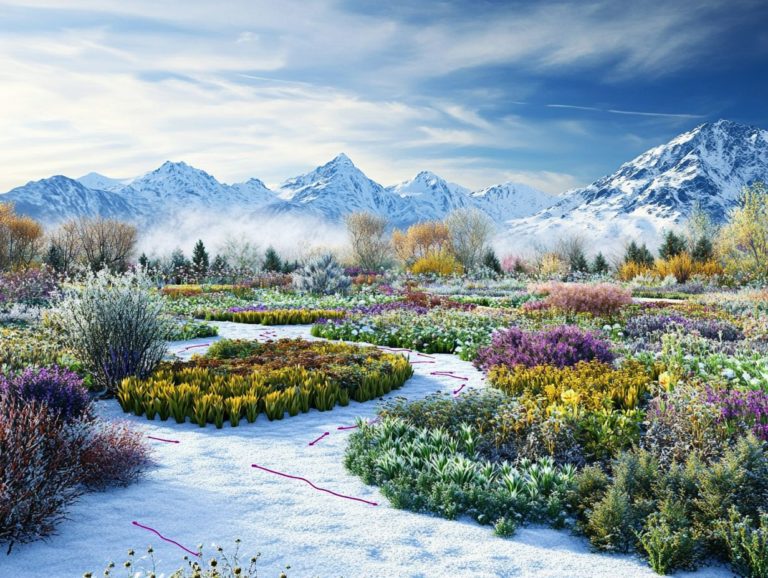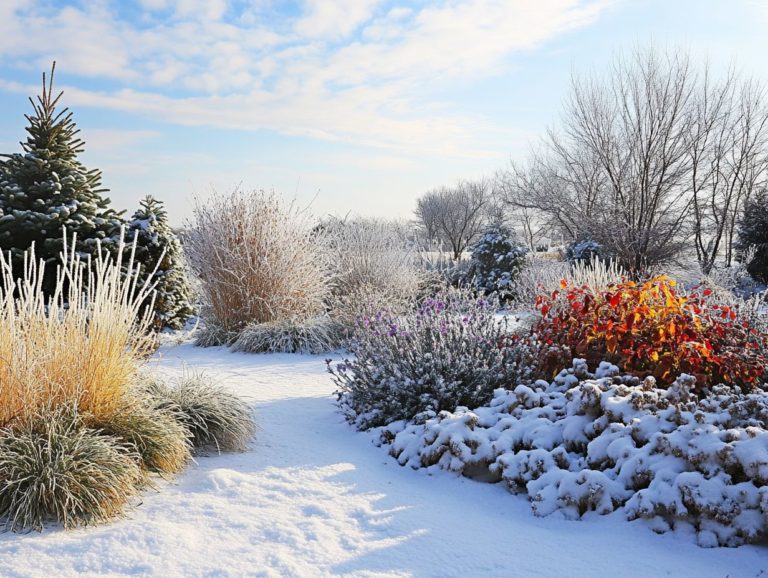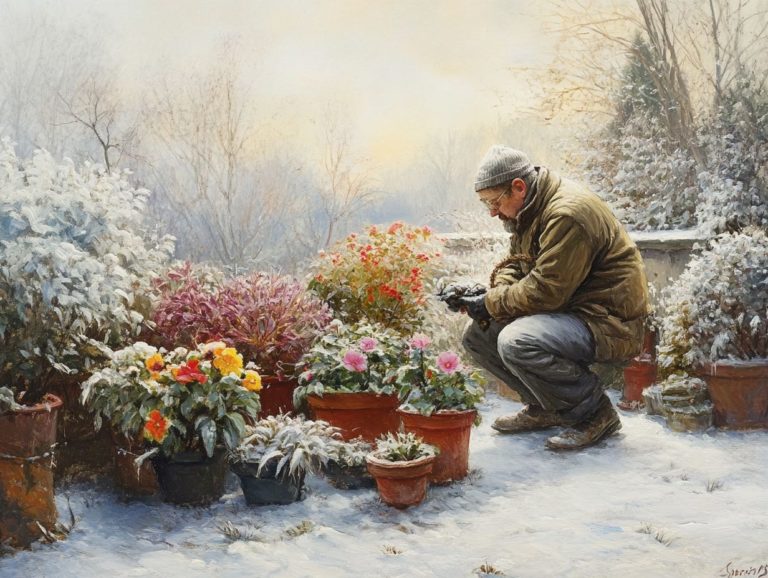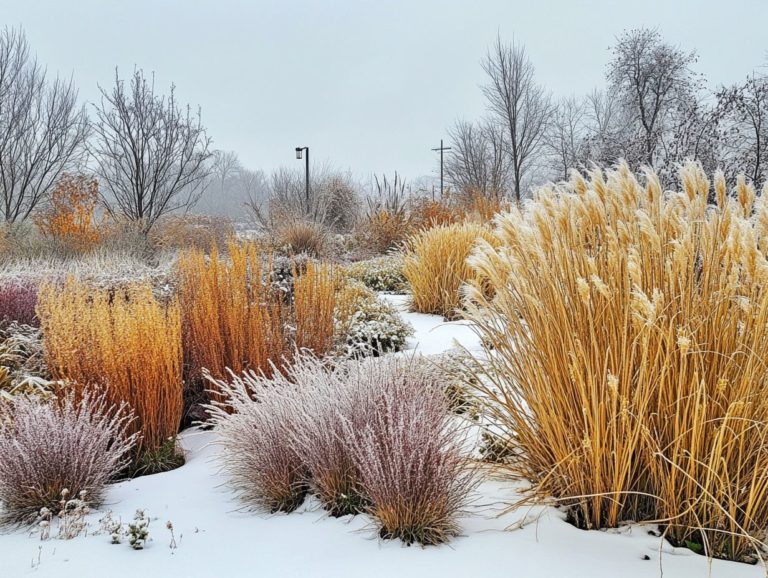Best Foliage Plants for Cold Climates
When it comes to gardening in cold climates, selecting the right foliage plants can truly transform your landscape. From vibrant ferns to resilient boxwoods, these choices not only withstand harsh winters but also flourish, adding beauty and texture to your garden throughout the year.
This article delves into a stunning array of plants that thrive in chilly environments, exploring how they endure the cold and offering tips for incorporating them into your garden. Whether you re aiming to elevate your outdoor space or simply curious about hardy plants, you ll find something here that caters to every gardener s needs.
Contents
- Key Takeaways:
- 1. Hardy Ferns
- 2. Ornamental Grasses
- 3. Wintergreen Boxwood
- 4. Creeping Phlox
- 5. Coral Bells
- 6. Winter Jasmine
- 7. Hellebores
- 8. Siberian Iris
- 9. Red Twig Dogwood
- 10. Lenten Rose
- 11. Japanese Painted Fern
- 12. Bergenia
- 13. Japanese Maple
- 14. Siberian Bugloss
- 15. Winterberry Holly
- What Makes These Plants Ideal for Cold Climates?
- Frequently Asked Questions
- What are the best foliage plants for cold climates, including lavender and showy stonecrop?
- Can I grow tropical plants in a cold climate?
- Do foliage plants, such as flowering tobacco, require special care in cold climates?
- What are some colorful foliage plants, like New England asters and Coreopsis verticillata, that can withstand cold temperatures?
- Can I grow ferns, such as Hyalotelephium spectabile and Heuchera spp., in a cold climate?
- Discover Easy Plants for Your Cold Climate Garden That Attract Wildlife!
Key Takeaways:
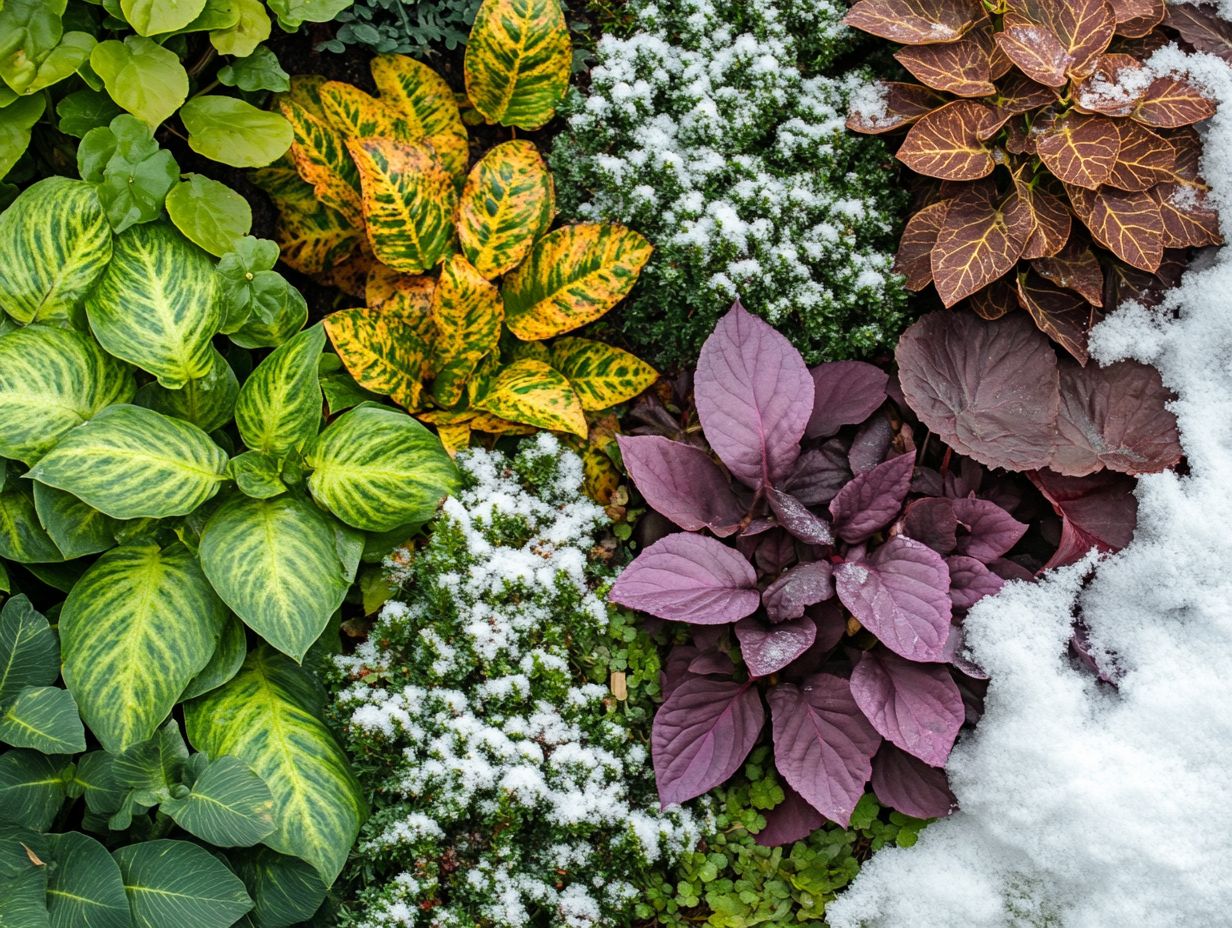
- Hardy ferns, ornamental grasses, and wintergreen boxwood add texture and color to cold climate gardens.
- Red twig dogwood and winterberry holly provide visual interest and vibrant color in winter.
- Foliage plants enhance beauty and offer benefits like erosion control and wildlife habitat.
1. Hardy Ferns
Hardy ferns are a remarkable group of cold-hardy perennials. They flourish in various growing conditions, making them essential for vibrant landscapes in winter. If you’re interested in expanding your garden, consider exploring the best native plants for cold climates. With their distinctive foliage and remarkable resilience, these plants withstand the rigors of cold climates while adding an appealing touch to your outdoor spaces.
Whether your focus is urban gardening or traditional landscapes, hardy ferns elevate your garden’s visual allure while offering vital benefits for local wildlife. Among many species, the Christmas fern and the lady fern stand out with their unique fronds and adaptability. These ferns not only boost aesthetics but also significantly contribute to soil health by preventing erosion and fostering biodiversity.
Eager to add hardy ferns to your garden? Consider integrating them into woodland gardens or using them as ground cover beneath trees. They thrive in shaded areas with moist, well-drained soil.
For care, maintaining consistent soil moisture and adding organic mulch will create a flourishing environment. This makes them a low-maintenance yet incredibly rewarding choice for any gardener.
2. Ornamental Grasses
Ornamental grasses bring distinctive charm and practicality to cold-hardy gardens. They infuse your landscape design with texture and movement while remaining drought-tolerant and low maintenance.
In regions where winters can be particularly unforgiving, choosing the right varieties is essential for maintaining a vibrant landscape year-round. For those interested in vertical gardening, exploring the best vertical garden plants for cold climates can be beneficial. Species such as Miscanthus, Panicum, and Calamagrostis thrive in frigid temperatures and champion sustainable gardening practices by requiring minimal water and offering habitat for local wildlife.
These grasses attract birds, butterflies, and beneficial insects, enhancing the biodiversity of your garden. To ensure optimal growth and visual appeal, plant them in well-drained soil and position them in sunny spots. Grouping them in clusters achieves a harmonious and cohesive look.
3. Wintergreen Boxwood
The wintergreen boxwood stands as a prime example of how cold-hardy plants can infuse your garden with year-round greenery. It thrives effortlessly in various urban gardening settings while providing exceptional structure and form.
Its versatility allows you to explore a range of design styles, from formal hedges to relaxed borders. This gives you the freedom to experiment with different aesthetics while maintaining a cohesive look. The wintergreen boxwood offers lush, vibrant greenery throughout the seasons, and its dense foliage serves as a striking backdrop for your seasonal blooms.
This hardy shrub demands minimal maintenance, making it a perfect choice for both novice and seasoned gardeners. A light pruning in late winter can help maintain its shape and promote healthy growth. With a bit of proper care like occasional fertilization and watering during dry spells you can revel in the many benefits of this remarkable plant all year long.
4. Creeping Phlox
Creeping phlox is a robust perennial that changes your garden with vibrant, colorful flowers in early spring! It’s a top choice for those eager to brighten their landscapes after winter’s chill.
These cheerful blooms create a stunning tapestry that captivates the eye! They showcase a spectrum from soft pinks and purples to vivid whites and blues. Perfect for ground cover, this adaptable plant flourishes in various conditions, thriving in both sun-drenched and partially shaded areas.
Pair creeping phlox with other flowering plants like daffodils or tulips! This adds a lush layer of texture and an explosion of color, enhancing the visual appeal of any garden. To ensure optimal growth and blooming, provide well-draining soil, regular watering during dry spells, and occasional deadheading removing faded flowers to encourage new growth.
5. Coral Bells
Coral bells are a delight, celebrated for their exquisite foliage and charming bell-shaped flowers! They thrive in various soil types, effortlessly adding both color and texture to your garden throughout the seasons.
These versatile plants offer an impressive spectrum of foliage colors, ranging from deep purples and vibrant greens to striking silvers and rich reds. They are ideal for creating vibrant garden displays! Their distinct textures whether glossy or ruffled add dynamic interest to your landscape. Preferring well-drained soil and partial shade, they flourish beautifully in both garden beds and containers.
With minimal maintenance needs, such as occasional watering and deadheading spent blooms, they harmoniously complement other perennials and flowering plants! This creates an enchanting tapestry of hues and forms, elevating the aesthetic of any outdoor space you create.
6. Winter Jasmine
Winter jasmine is the perfect companion for your garden during chilly months! It brings a burst of warmth and color with its cheerful yellow blooms that often appear just before the last frost of winter.
This resilient shrub thrives in various conditions and features a sprawling growth habit. It’s an excellent choice for cascading over walls or gracefully tumbling down slopes. Its slender, arching stems and delicate foliage create a stunning contrast against the starkness of winter landscapes, offering a welcoming sight as the days gradually warm.
By strategically placing winter jasmine near walkways or in borders, you can elevate the charm of your garden design in early spring! Pair it with other early bloomers like crocuses and snowdrops to foster a vibrant tapestry of colors that heralds the arrival of the new season.
7. Hellebores
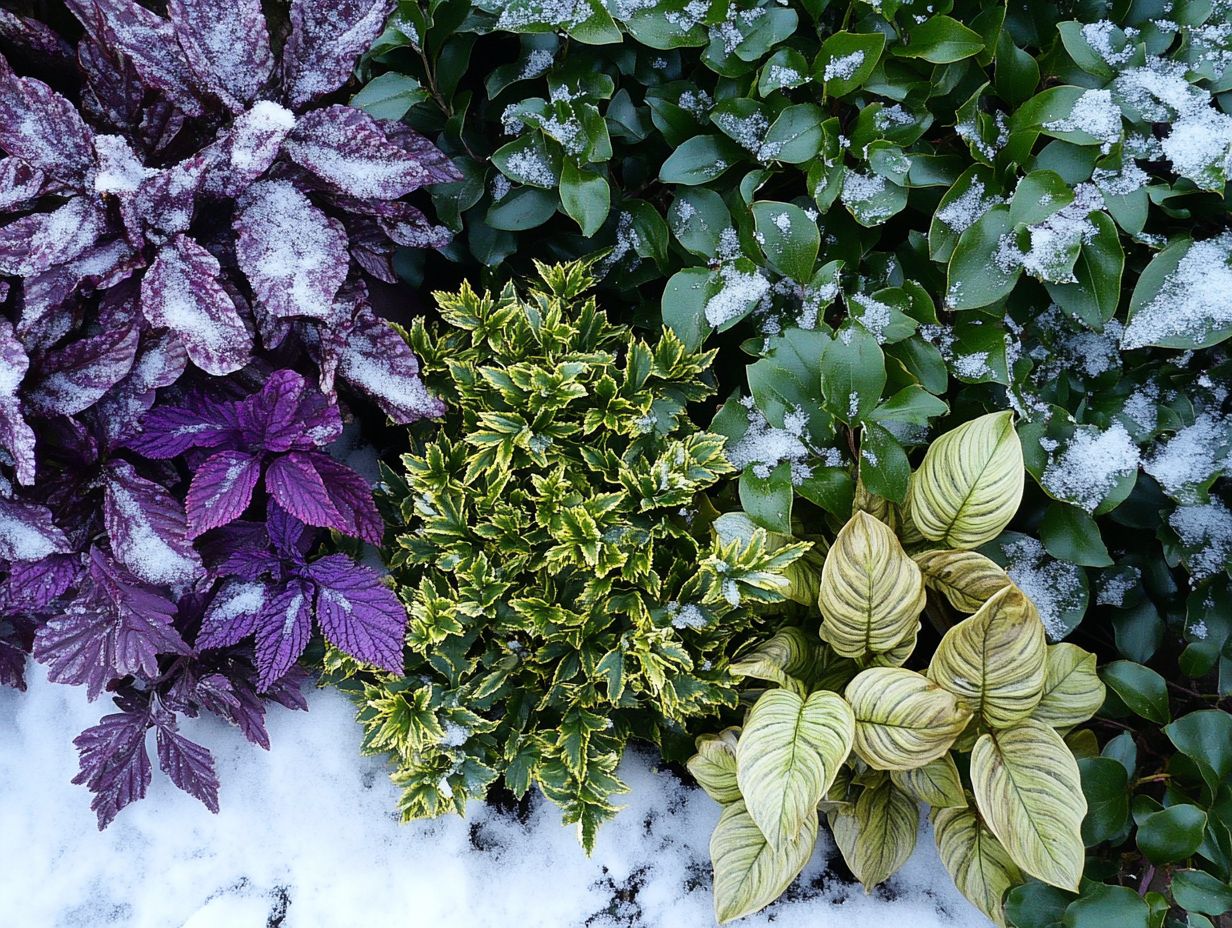
Hellebores, often known as Lenten roses, are the cold-hardy perennials you ll want to include in your garden! They bloom from late winter to early spring, showcasing a stunning range of colors that elevate your seasonal gardening efforts.
These enchanting plants come in several varieties. The renowned Helleborus orientalis boasts impressive blossoms, and the striking Helleborus niger features pristine white flowers. To thrive, they prefer well-drained soil and partial to full shade, making them perfect for woodland gardens or shaded borders.
Regular watering and mulching will help retain moisture and keep those pesky weeds at bay. Since they flower when many other plants are still in their winter slumber, incorporating hellebores into your garden adds essential early-season interest! Watch as they transform your garden into a vibrant showcase before the glorious arrival of spring blooms.
8. Siberian Iris
The Siberian iris is a resilient perennial that boasts strikingly colorful flowers, thriving in moist soils. This makes it an excellent choice for your garden design, blending beauty with practicality seamlessly.
With a spectrum of colors from deep blues and purples to delicate whites and yellows, these irises will create vibrant splashes in your garden. Typically growing between 18 to 36 inches tall, they thrive in full sun to partial shade and prefer well-drained, rich soil.
Incorporating them into your garden beds or borders can create a stunning contrast alongside other perennials like daylilies or hostas.
To ensure healthy growth, regular watering is essential, particularly during dry spells. Deadheading spent blooms, or removing spent flowers to encourage new blooms, will further enhance your garden’s allure.
A light application of fertilizer in early spring will support their robust development, ensuring that your Siberian irises remain the stars of the show.
9. Red Twig Dogwood
Red twig dogwood brings vibrant winter flair to your landscape with its striking red stems. It offers not just beauty but also crucial habitat for wildlife during the cold months.
This deciduous shrub stands out brilliantly against the snow, creating focal points that draw the eye throughout winter.
Its dense foliage and branching structure provide shelter for pollinators and other wildlife, enhancing biodiversity in your outdoor space.
To encourage optimal growth, remember to prune your red twig dogwood at the end of winter. This will stimulate those vividly colored new shoots you love.
Keeping the soil consistently moist and adding mulch in your garden beds can further boost its health. This makes it a resilient choice for any garden enthusiast eager to craft a four-season sanctuary.
10. Lenten Rose
The Lenten rose, or hellebore, is a hardy plant that can survive cold weather. It graces your garden with elegance and color in late winter, when most plants are still in hibernation mode.
With a variety of cultivars at your disposal, including the stunning Winter Jewels series and the timeless Niger , you can enjoy a spectrum of colors ranging from soft pastels to rich, deep purples.
Hellebores thrive in shady to partially shaded spots, making them perfect for woodland gardens or nestled beneath deciduous trees. Their evergreen foliage adds year-round interest, while unique flowers can serve as striking borders or captivating focal points in your garden beds.
To ensure they continue to thrive season after season, it’s wise to mulch in spring. This will help retain moisture and protect the roots during the colder months, allowing these beautiful perennials to flourish in your garden for years to come.
11. Japanese Painted Fern
The Japanese painted fern is a breathtaking, cold-hardy perennial that you ll adore for its unique, multicolored fronds that attract pollinators. This feature makes it a standout in any garden design that celebrates texture and color diversity found in dahlias and showy stonecrop.
These dynamic ferns thrive in moist, well-drained soils ideal for fragrant flowers like lavender and ornamental grasses. Enriching the soil with organic matter is vital for gardening success. They prefer a slightly acidic pH for optimal growth. You ll find that they flourish in partial to full shade, where pollinators can gather. Their vibrant greens really pop against darker foliage, creating a serene yet colorful atmosphere.
Caring for them also involves regular watering, especially during dry spells. Applying a layer of mulch can be beneficial for moisture retention. By adding this fern to your shade gardens, you enhance their beauty and contribute to a layered aesthetic. This transformation can turn dull corners into lush retreats with native plants and community engagement that draw the eye and elevate the overall garden experience.
12. Bergenia
Bergenia, often called elephant ears, is a remarkably cold-hardy perennial that stands out for its large, glossy leaves and stunning spring blooms. This plant thrives in a range of different levels of soil moisture, showcasing its adaptability.
To create the ideal environment for Bergenia, you’ll want to ensure it flourishes in well-draining, rich soil that retains some moisture. This makes it perfect for shaded or partially shaded areas in your garden.
In landscaping, you have the freedom to plant Bergenia as:
- a border in flower beds featuring peonies and a type of flower called Coreopsis verticillata
- ground cover including angustifolia and Symphyotrichum novae-angliae that brings late-season color to your garden
- featured in rock gardens alongside Digitalis purpurea, commonly known as foxglove, which can add height and interest to garden designs for a stunning look
Its versatility and vibrant colors can effortlessly enhance any design.
For optimal blooming, regular pruning of coneflower and bee balm will help maintain its shape. Consistent watering during dry spells will provide the best conditions for this eye-catching plant. Enriching the soil with organic matter will further boost its growth, leading to lush foliage and striking flowers that are sure to impress.
13. Japanese Maple
The Japanese maple is an exquisite ornamental tree that captivates with its stunning foliage and graceful form, thriving beautifully in cold environments! This makes it a prized choice for your landscape design.
Consider the various cultivars, such as the enchanting ‘Bloodgood’ with its deep red leaves or the delicate ‘Shirazz’, which showcases a unique blend of green, white, and pink hues. These trees can effortlessly enhance any garden aesthetic enhanced by the integration of flowering plants.
For optimal growth, focus on well-drained, slightly acidic soil and partial shade. This allows them to flourish without the risk of leaf scorch caused by harsh sunlight. When you incorporate them into your garden designs, they can serve as striking focal points or elegant border specimens, adding vibrant color and texture throughout the seasons.
To keep your Japanese maples healthy, ensure regular watering during dry spells, practice minimal pruning to maintain their shape, and protect them from extreme winter cold. This attention to care will help preserve their vibrant display and keep them looking their best. Imagine the beauty these trees can bring to your garden!
14. Siberian Bugloss
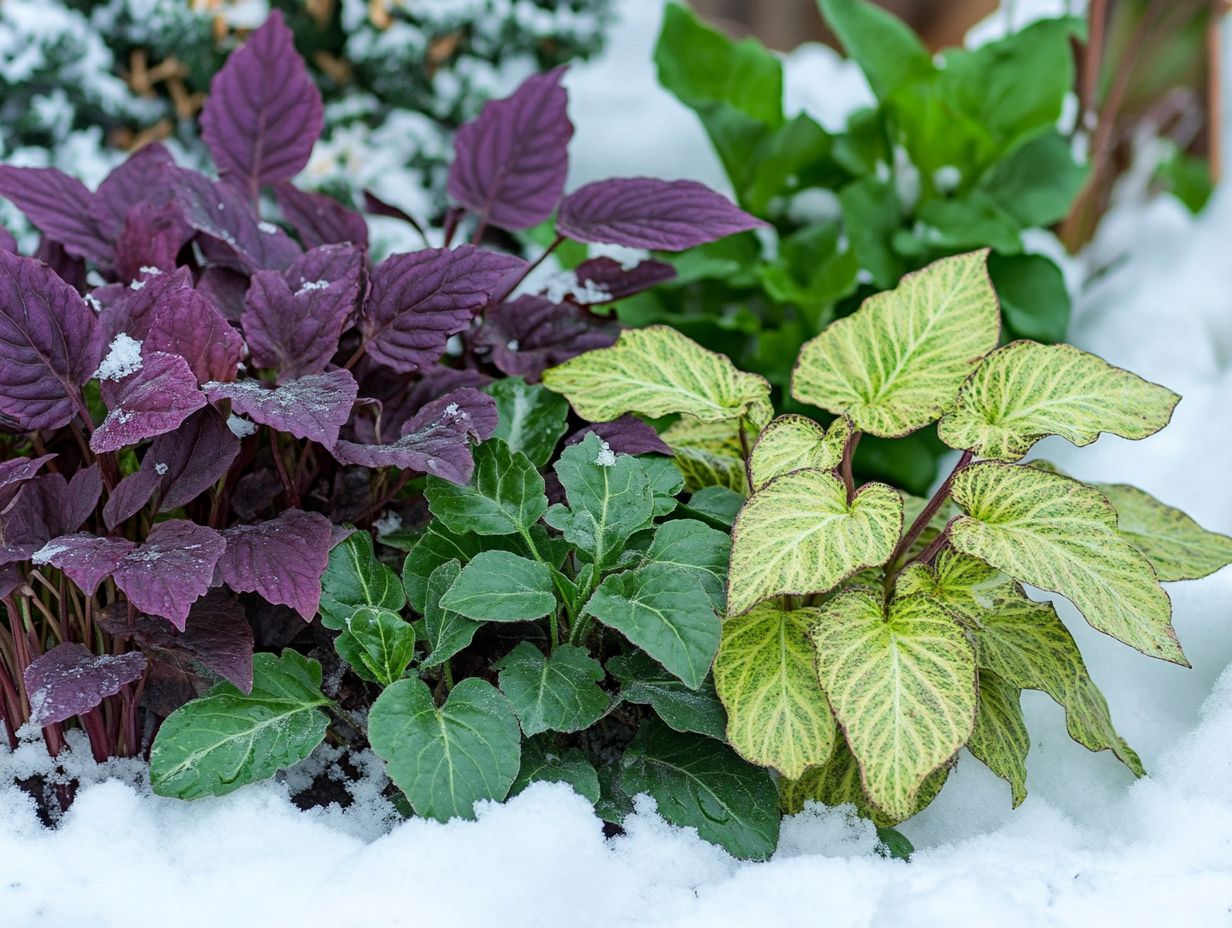
Imagine a splash of blue in your garden that thrives through the cold! Siberian bugloss is a hardy plant that survives cold weather that adds a dazzling touch of blue to your garden, effortlessly thriving in a variety of soil types.
This versatile species flourishes in environments ranging from well-drained sandy soils to rich, moist loams. With the right balance of moisture especially during its growing season this plant plays a vital role in attracting pollinators.
Incorporating Siberian bugloss into your garden design can create a dynamic landscape, especially when paired with complementary foliage. Regular maintenance, such as removing spent flowers and occasionally dividing the plants, will ensure that this vibrant perennial continues to thrive.
15. Winterberry Holly
Winterberry holly is a captivating cold-hardy shrub that can transform your winter landscape with its vibrant red berries, providing a crucial food source for wildlife during the colder months.
This plant that loses its leaves in winter, called Ilex verticillata, thrives in wet, acidic soils that promote the growth of flowering plants. It can adapt beautifully to various environments, from marshes to your garden. Its remarkable ability to tolerate a range of light conditions from full sun to partial shade makes it an excellent choice if you’re looking to enhance your garden’s aesthetic.
Incorporating this shrub enriches the visual appeal of your landscape while offering essential sustenance for birds and other wildlife.
To maximize berry production, plant both male and female varieties to ensure effective pollination. Regular pruning will help you shape the plant and promote healthy growth, attracting a diverse array of species to your garden.
What Makes These Plants Ideal for Cold Climates?
Plants that thrive in cold climates, such as winterberry holly, Siberian iris, and hellebores, are expertly adapted to withstand harsh conditions. For those looking to enhance their garden’s beauty, consider the top 10 plants for fall color in cold climates, making them ideal selections for sustainable gardening practices that incorporate wildlife gardening elements.
These cold-hardy perennials boast unique root structures that allow them to anchor securely in frozen soil, ensuring stability through seasonal changes. For those interested in enhancing their gardens, selecting plants for shade in cold climates can be particularly beneficial. Their foliage often features a waxy coating that minimizes moisture loss, enabling them to brave the dry winter winds.
Take the Siberian iris, for example. It bursts into vibrant bloom early in spring, attracting pollinators when food sources are scarce. Likewise, hellebores flaunt their delightful flowers even beneath a blanket of snow, adding visual interest and a splash of color when most other plants are hibernating.
Incorporating such resilient species into your garden design promotes biodiversity and reduces the reliance on chemical fertilizers, leading to a more eco-friendly gardening approach.
How Do These Plants Survive in Cold Climates?
The survival of cold-hardy plants in harsh climates is a fascinating dance of adaptations. You ll find that their specialized root systems, unique leaf structures, and remarkable ability to tolerate poor soil types all play a crucial role, allowing them to flourish even when winter unleashes its worst.
These resilient plants enter a remarkable dormancy period that allows them to conserve energy during winter, significantly slowing the plant’s life functions until conditions become more favorable. Their frost-resistant features like flexible cell walls and antifreeze proteins enable them to brave extreme temperature drops without succumbing to cell damage.
Deep roots are their secret weapon, allowing them to access moisture and nutrients from deeper soil layers, which ensures both stability and sustenance during droughts and freezing conditions. Take, for example, the Arctic willow and certain types of heather; these species embody these adaptations, greatly enhancing their survival odds in diverse and challenging environments.
What Are the Benefits of Having Foliage Plants in a Cold Climate?
In cold climates, foliage plants like Hosta are perfect for shaded areas with moisture-rich soils. They offer year-round interest and a wealth of benefits that you simply can’t overlook. For those looking to enhance their gardens, exploring the best plants for small cold-climate gardens can provide essential shelter and food for wildlife, support sustainable gardening practices, and add aesthetic appeal during the often dreary winter months.
Their resilience in harsh conditions shelters a variety of species, from birds seeking refuge to insects relying on foliage for survival. They also play a vital role in maintaining a balanced ecosystem. Picture your landscape bursting with vibrant colors and textures that catch the eye, even when most flowers have long faded. Evergreens and hardy perennials stand proudly against snow and frost, turning your garden into a winter wonderland!
Add these fantastic plants to your landscape! They create inviting outdoor spaces brimming with life and character while promoting ecological health.
How Can These Plants Be Incorporated into Landscaping?
Incorporating cold-hardy plants into your landscaping requires a basic understanding of their unique characteristics and growing conditions. This knowledge enables you to create a harmonious blend that enhances both the beauty and functionality of your garden design.
As you explore this process, thoughtfully consider various landscaping techniques. Layering plants can add depth and texture, while color coordination brings visual interest that changes with the seasons. Position each species according to their specific sunlight and moisture needs. For example, taller cold-hardy plants can serve as an elegant backdrop, allowing vibrant ground covers to spring forth in a lively foreground.
To ensure successful integration, pay close attention to soil type and drainage. Consider proper spacing to promote air circulation, which helps prevent disease and enhances the overall health of your landscape.
What Are Some Tips for Caring for These Plants in Cold Climates?
Caring for plants in cold climates requires you to understand their specific needs, such as managing soil moisture, shielding them from harsh winter weather, and applying appropriate pruning techniques to foster healthy growth.
To keep your resilient plants thriving, establish a consistent watering routine that ensures the soil remains adequately moist but never waterlogged. As colder months approach, adjust your watering frequency, as plants naturally use less water due to reduced evaporation. Adding a layer of mulch not only helps retain soil moisture but also serves as a protective barrier against extreme temperatures, especially for hardy banana and elephant ear.
Regularly monitoring weather conditions allows you to anticipate changes and provide the necessary care. When it comes to pruning, take the time to understand each species’ growth habits to enhance vitality without causing undue stress.
Frequently Asked Questions
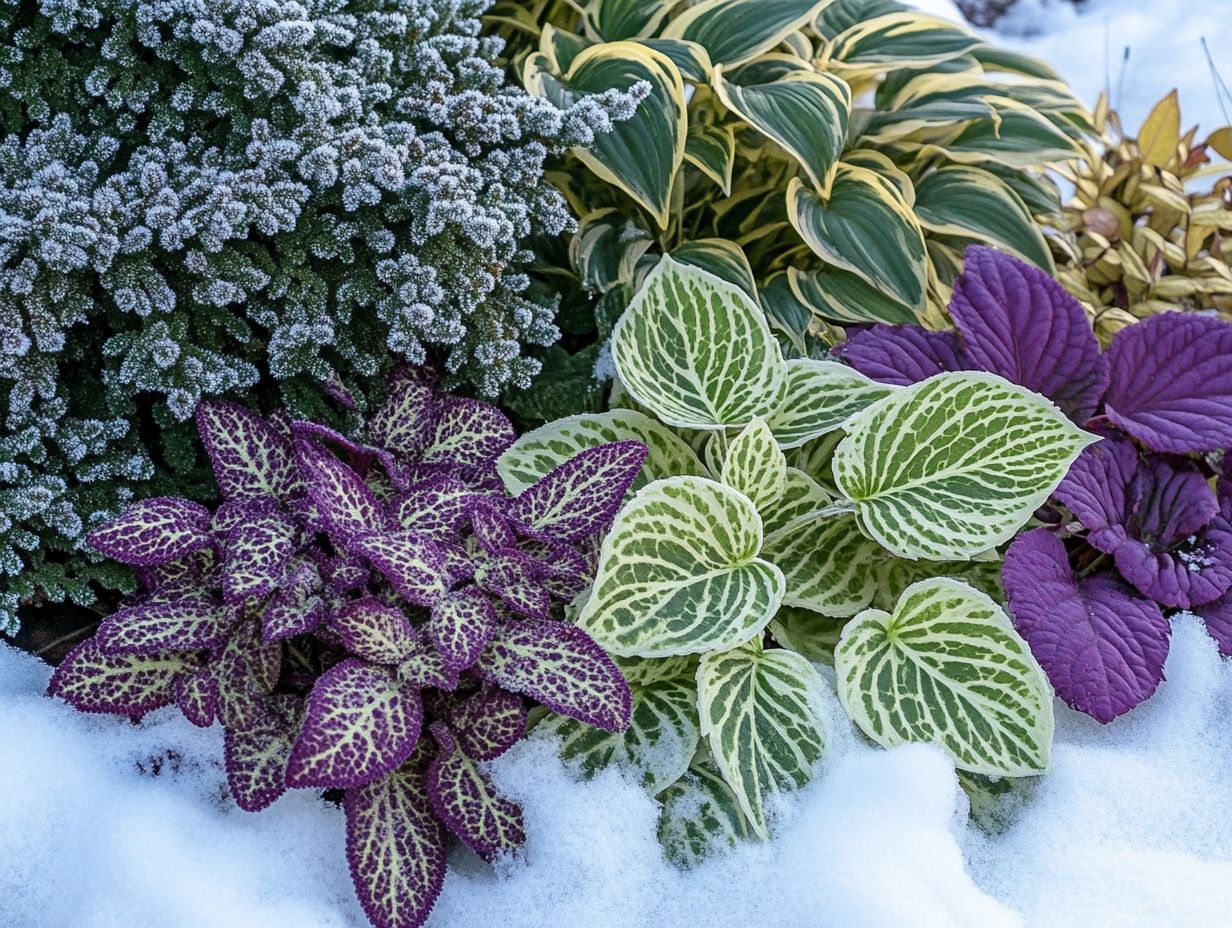
What are the best foliage plants for cold climates, including lavender and showy stonecrop?
Some of the best foliage plants for cold climates include evergreens, conifers, and hollies.
Can I grow tropical plants in a cold climate?
It is not recommended to grow tropical foliage plants in a cold climate, as they require warm temperatures and high humidity to thrive.
Do foliage plants, such as flowering tobacco, require special care in cold climates?
Yes, foliage plants in cold climates may need extra protection during the winter months, such as mulching and covering with burlap or fabric. For more information, consider choosing the right plants for cold climates.
What are some colorful foliage plants, like New England asters and Coreopsis verticillata, that can withstand cold temperatures?
Some colorful foliage plants that can withstand cold temperatures include Japanese maples, purple beech, and best plants for shade gardens in cold climates, such as variegated boxwoods.
Can I grow ferns, such as Hyalotelephium spectabile and Heuchera spp., in a cold climate?
Yes, many fern varieties thrive in cold climates, such as holly ferns, autumn ferns, and ostrich ferns.
Discover Easy Plants for Your Cold Climate Garden That Attract Wildlife!
If you live in a cold climate, there are many low-maintenance plants to choose from.
Yews, junipers, and spruce trees are great options. These low-maintenance plants for cold climates not only thrive in chilly weather but also help support local wildlife.

